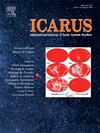Volcanism along the rings of the Crisium Basin on the Moon: Insights from M3 onboard Chandrayaan - 1
IF 3
2区 物理与天体物理
Q2 ASTRONOMY & ASTROPHYSICS
引用次数: 0
Abstract
The Crisium Basin (17.0°N, 59.1°E) is a Nectarian multi-ring basin hosting extensive volcanism inside the basin center and along its four rings. The Crisium Basin is an essential proxy for understanding basin-related magmatic activity on the Moon. A detailed stratigraphy and chronology have been established for the Mare Crisium in several earlier studies. However, there has been no comprehensive study regarding the composition and emplacement timescales of the basalts along the rings of the Crisium Basin. The basalts along the rings of the Crisium Basin have been emplaced within Mare Undarum, Mare Spumans, Mare Anguis, Cleomedes Crater, and Lacus Bonitatis. Our recent study identified Marginis West as an episode of volcanism along the outermost ring of the Crisium Basin. This study, for the first time, examines the compositional diversity and ages of the basalts emplaced along the rings of the Crisium Basin to better understand its geological evolution. We report the youngest volcanic unit emplaced inside the Crisium Basin at ∼2.0 Ga inside Mare Anguis. Based on the spectral signatures, we report that the contemporaneously formed mare units within the Crisium Basin are compositionally different, displaying a westward increase in Ca, and large pre-existing crustal structures would have deeply influenced the volcanism within the basin in the region.
沿着月球危机盆地环的火山活动:来自月船1号上M3的见解
危机盆地(17.0°N, 59.1°E)是一个东北多环盆地,在盆地中心及其四个环内存在广泛的火山活动。危机盆地是了解月球上与盆地相关的岩浆活动的重要代表。在早期的一些研究中,已经为危机海建立了详细的地层学和年代学。然而,目前对危机盆地环缘玄武岩的组成和侵位时间尺度尚未有全面的研究。沿着危机盆地环的玄武岩被安置在翁达鲁姆海、斯巴曼斯海、安圭斯海、克利奥米德斯陨石坑和博尼塔蒂斯湖。我们最近的研究将边际西确定为沿危机盆地最外环的火山活动的一个片段。本研究首次考察了沿危机盆地环位的玄武岩的成分多样性和年龄,以更好地了解其地质演化。我们报告了位于马雷安圭斯(Mare Anguis)内部约2.0 Ga的危机盆地内最年轻的火山单元。基于光谱特征,我们认为危机盆地内同时期形成的海单元在成分上存在差异,表现出向西增加的Ca,并且大型的已存地壳结构可能对该地区盆地内的火山活动产生了深刻的影响。
本文章由计算机程序翻译,如有差异,请以英文原文为准。
求助全文
约1分钟内获得全文
求助全文
来源期刊

Icarus
地学天文-天文与天体物理
CiteScore
6.30
自引率
18.80%
发文量
356
审稿时长
2-4 weeks
期刊介绍:
Icarus is devoted to the publication of original contributions in the field of Solar System studies. Manuscripts reporting the results of new research - observational, experimental, or theoretical - concerning the astronomy, geology, meteorology, physics, chemistry, biology, and other scientific aspects of our Solar System or extrasolar systems are welcome. The journal generally does not publish papers devoted exclusively to the Sun, the Earth, celestial mechanics, meteoritics, or astrophysics. Icarus does not publish papers that provide "improved" versions of Bode''s law, or other numerical relations, without a sound physical basis. Icarus does not publish meeting announcements or general notices. Reviews, historical papers, and manuscripts describing spacecraft instrumentation may be considered, but only with prior approval of the editor. An entire issue of the journal is occasionally devoted to a single subject, usually arising from a conference on the same topic. The language of publication is English. American or British usage is accepted, but not a mixture of these.
 求助内容:
求助内容: 应助结果提醒方式:
应助结果提醒方式:


